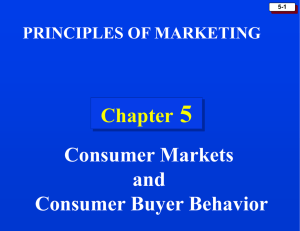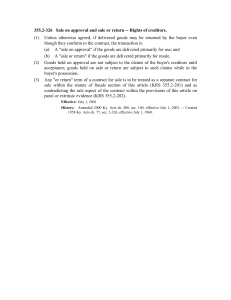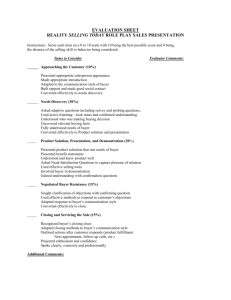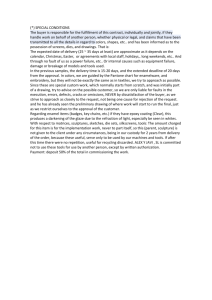kotler 6
advertisement
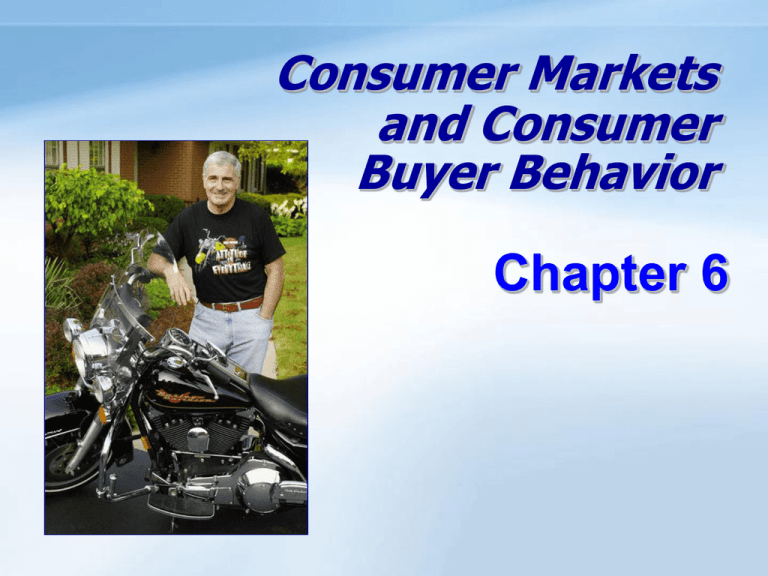
Consumer Markets and Consumer Buyer Behavior Chapter 6 Objectives Be able to define the consumer market and construct a simple model of consumer buyer behavior. Know the four major factors that influence consumer buyer behavior. 6-1 Objectives Understand the major types of buying decision behavior and the stages in the buyer decision process. Be able to describe the adoption and diffusion process for new products. 6-2 c Harley-Davidson Harley “Hogs” account for 1/5 of U.S. cycle sales Sales have exceeded supply for years 1986-2000: Four stock splits, increase of 7,100% Fiercely loyal clientele revolves around 7 core customer types Harley owners use their bikes to express their lifestyle and attitudes Advertising reflects the Harley mystique 6-3 Definitions Consumer Buying Behavior Buying behavior of individuals and households that buy products for personal consumption. Consumer Market All individuals/households who buy products for personal consumption. 6-4 Figure 6-1: Model of Buyer Behavior 6-5 Model of Consumer Behavior Stimulus Response Model Marketing and other stimuli enter the buyer’s “black box” and produce certain choice / purchase responses. Marketers must figure out what is inside of the buyer’s “black box” and how stimuli are changed to responses. ? 6-6 Figure 6-2: Factors Influencing Consumer Behavior 6-7 Characteristics Affecting Consumer Behavior Key Factors Cultural Social Personal Psychological Culture Subculture Hispanic consumers African Americans Asian Americans Mature consumers Social Class 6-8 Characteristics Affecting Consumer Behavior Hispanics 35 million consumers purchase $425 billion worth of goods and services. Expected to grow 64% in 20 years. Spanish media makes group easy to reach. Brand loyal group. 6-9 Sears uses the Fiesta mobile to visit Hispanic neighborhoods regularly 6 - 10 Characteristics Affecting Consumer Behavior African Americans 35 million consumers purchase $527 billion worth of goods and services. Growing more affluent / sophisticated. Price and brand name conscious; quality and selection are important. Certain media target this group. 6 - 11 Hallmark offers an Afrocentric line of greeting cards called Mahogany. What other brands have been targeted specifically to African Americans? 6 - 12 Characteristics Affecting Consumer Behavior Asian Americans 10 million consumers purchase $229 billion worth of goods and services. Fastest growing, most affluent subculture. Many nationalities comprise this group. Consumer packaged goods firms now target this group more heavily. 6 - 13 Characteristics Affecting Consumer Behavior Mature Consumers 75 million consumers age 50+will grow to 115 million within 25 years. Mature consumers control 50% of all discretionary income. Attractive market for travel, restaurant, and cosmetics products, among others. 6 - 14 Characteristics Affecting Consumer Behavior Key Factors Cultural Social Personal Psychological Groups Membership Reference Aspirational groups Opinion leaders Buzz marketing Family Kids can influence Roles and Status 6 - 15 Characteristics Affecting Consumer Behavior Key Factors Cultural Social Personal Psychological Age and life-cycle Occupation Economic situation Lifestyle Activities, interests, and opinions Lifestyle segmentation Personality and selfconcept Brand personality 6 - 16 Lifestyles: Jeep targets people who want to “leave the civilized world behind” What other types of images could be used to appeal to this lifestyle? 6 - 17 Figure 6-3: VALS Lifestyle Classification Learn more about VALS and take the VALS survey online by clicking the web link icon below. 6 - 18 Characteristics Affecting Consumer Behavior Brand Personality Dimensions Sincerity Excitement Ruggedness Competence Sophistication 6 - 19 Think about Tide detergent. What brand personality seems to describe Tide best? Can you think of examples of brands that fit each personality type? 6 - 20 Characteristics Affecting Consumer Behavior Key Factors Cultural Social Personal Psychological Motivation Needs provide motives Motivation research Maslow’s hierarchy of needs Perception Selective attention, selective distortion, selective retention Learning Drives, stimuli, cues, responses and reinforcement Beliefs and attitudes 6 - 21 Figure 6-4: Maslow’s Hierarchy 6 - 22 The milk moustache campaign changed attitudes toward milk. 6 - 23 Figure 6-5: Types of Buying Behavior 6 - 24 Figure 6-6: The Buyer Decision Process 6 - 25 The Buyer Decision Process Stages Need recognition Information search Evaluation of alternatives Purchase decision Postpurchase behavior Needs can be triggered by: Internal stimuli Normal needs become strong enough to drive behavior External stimuli Advertisements Friends of friends 6 - 26 Attempt to stimulate need recognition 6 - 27 The Buyer Decision Process Stages Need recognition Information search Evaluation of alternatives Purchase decision Postpurchase behavior Consumers exhibit heightened attention or actively search for information. Sources of information: Personal Commercial Public Experiential Word-of-mouth 6 - 28 The Buyer Decision Process Stages Need recognition Information search Evaluation of alternatives Purchase decision Postpurchase behavior Evaluation procedure depends on the consumer and the buying situation. Most buyers evaluate multiple attributes, each of which is weighted differently. At the end of the evaluation stage, purchase intentions are formed. 6 - 29 The Buyer Decision Process Stages Need recognition Information search Evaluation of alternatives Purchase decision Postpurchase behavior Two factors intercede between purchase intentions and the actual decision: Attitudes of others Unexpected situational factors 6 - 30 The Buyer Decision Process Stages Need recognition Information search Evaluation of alternatives Purchase decision Postpurchase behavior Satisfaction is key: Delighted consumers engage in positive word-of-mouth. Unhappy customers tell on average 11 other people. It costs more to attract a new customer than it does to retain an existing customer. Cognitive dissonance 6 - 31 Buyer Decision Process for New Products New Products Good, service or idea that is perceived by customers as new. 6 - 32 Buyer Decision Process for New Products Stages in the Adoption Process Marketers should help consumers move from awareness to adoption. 6 - 33 Buyer Decision Process for New Products Stages in the Adoption Process Awareness Evaluation Interest Trial Adoption 6 - 34 Buyer Decision Process for New Products Individual Differences in Innovativeness Consumers can be classified into five adopter categories, each of which behaves differently toward new products. 6 - 35 Figure 6-7: Adopter Categories Based on Relative Time of Adoption 6 - 36 Buyer Decision Process for New Products Product Characteristics and Adoption Five product characteristics influence the adoption rate. 6 - 37 Buyer Decision Process for New Products Product Characteristics Relative Advantage Compatibility Complexity Divisibility Communicability 6 - 38 Discussion Question Describe how each of the five productrelated innovation characteristics will influence the rate of the adoption for this product. 6 - 39 Buyer Decision Process for New Products International Consumer Behavior Values, attitudes and behaviors differ greatly in other countries. Physical differences exist that require changes in the marketing mix. Customs vary from country to country. Marketers must decide the degree to which they will adapt their marketing efforts. 6 - 40
